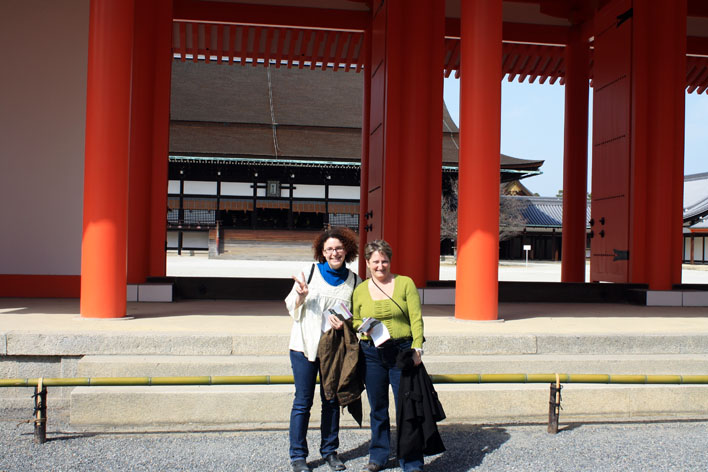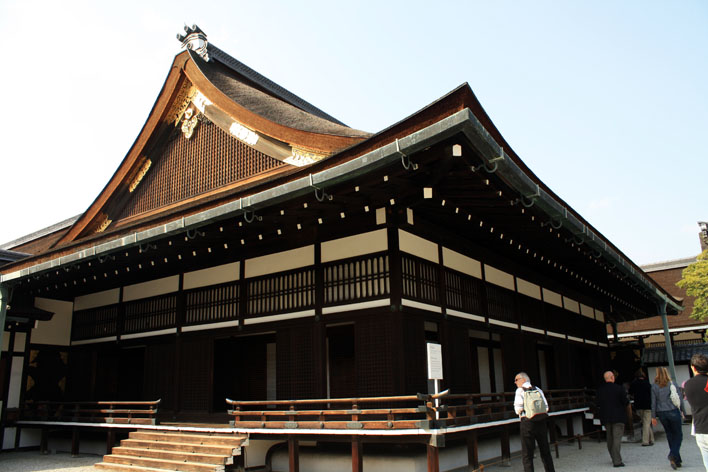Spring Break: Day 4
Our last day exploring Kyoto, we decided we would visit the Imperial Palace. It was within walking distance of our hotel, so we again set out by subway–bound for what we hoped to be landscape just as beautiful as the Heian Shrine’s gardens.
[singlepic=414,320,240,,left]We arrived on the Imperial Grounds after rounding a wall of shrubs and trees. The grounds itself is composed mostly of trees and plots of landscaping between wide gravel roads. Altogether the gardens and the included buildings cover Being a weekday the place was quiet and peaceful, with only a handful of bikes lined up by the entrance and a few sight-seers meandering around. Some of the trees were starting to bloom and we joined other people stopping to take photos of the fresh blossoms. Most of the flowers were (I think) plum and dogwood, but there were a few early sakura trees also starting to flower.
[singlepic=440,320,240,,right]Coming up on the entrance to the palace, we were directed to another administration building. In order to tour the palace we had to obtain (free) tickets, showing our passports before we were cleared for entrance. I found this odd, but I suppose they don’t want terrorists touching one of their emperor’s palaces, right? It just made me wonder if they do the same thing in D.C. with the White House. I will have to find out one of these days. In any case, the next English tour was not for another three hours, so we had a lot of time to kill. Looking at our map, I pointed out that Nijo Castle was within walking distance. We could head over there and back before the tour started.
Down one street and down another, what looked like a short walk turned into 1.5 miles. It was a hot day, too, and we baked in the sun as we passed the many stores and restaurants. We paused to browse inside one shop with a bunch of high-tech toilets. Dad thought those were pretty funny…I wondered how it would be possible to get one of those home to the states. I wouldn’t mind a butt-warming toilet in the winter time.
[singlepic=463,320,240,,left]We continued to Nijo and paid the ¥600 to get inside. The grounds were well kept, and there were signs that explained the history of its buildings and the people who owned them. The signs were all in at least four languages (Japanese, English, Korean and Chinese), and there were a few signs that also had multilingual audio shows. It was probably the most informational site I’ve been to in Japan, which is exciting for me. I love learning about historical sites, and often Japanese temples and shrines don’t have enough information for my curiosity.
The castle was built by Shogun Tokugawa Ieyasu, the man responsible for establishing the Edo-based shogunate. The interior is painted by some of the best Kano School painters during the 1600s. Nijo Castle was also the same place where the last Tokugawa shogun resigned in 1867. We weren’t allowed to take photos inside the building, and all the sliding doors are kept closed to preserve the interior decoration. We also had to go barefoot, our shoes kept at the entrance in their own cubbies. Mom and Dad sure weren’t used to that!
My favorite part of the entire castle (and I say castle loosely…when you are used to a castle being a solid stone fortress, a series of small wooden rooms hardly seems the same) were the floors. Tokugawa Ieyasu was a smart one, you see. He anticipated that lords from surrounding areas would try to kill him and take power for themselves, so when he had the castle built he had then specially designed to squeak when someone walked on them. This works due to sheer gravity of a person’s weight, shifting the floor boards and the nails so they would rub together and emit a gentle “chirp” sound. For this reason they are labeled “nightingale floors.” I spent most of my time trying to trick the floors, walking softly in my socked feet like the ninja I truly think myself to be. Unfortunately, I’m not made of air, and the floors held true. Darn physics.
[singlepic=477,320,240,,right]After we made our way through all the different rooms (admiring the mannequins set up to imitate old Japanese fuedal lords or the shogun and his servants) we toured the gardens. There were a lot of rock and water elements, and of the course the usual manicured plant-life. I am constantly impressed by Japanese gardens and the amount of work that goes into shaping trees. I don’t know that I would ever have that much patience.
We made it through most of the garden before we realized that 2:00 was coming up extremely fast. We had thirty minutes to walk the 1.5 miles back to the Imperial Palace entrance. Dad took the lead at what I like to call his, “ten-mile-boy-scout-hiking-gait,” practically leaving my mom and me behind, scrambling to keep up. Breathless, and with feet that felt like thin taffy, we made it back to the palace in time for the tour.
[singlepic=533,320,240,,right]The Imperial Palace is giant, and composed of large wooden buildings of different design and of different time periods. It is true that most of the old buildings in Japan were at one time burnt down, and that held true for the palace. Parts of it have been rebuilt time and time again. I guess that is what happens when earthquakes, candles and wooden structures combine. In any case,we started at what is called the Okurumayose. This was the entrance used for official visits by courtiers. We learned that the roof on many Japanese buildings is made of layers upon layers of cypress bark chips. A new layer has to be laid down every year or so.
[singlepic=513,320,240,,left]The next building had sliding doors and paintings and was called the Shodaibunoma, which was used as a waiting room for visiting dignitaries. They were placed in one of the three rooms according to their rank–the highest in the Tiger Room, then the Crane Room, and finally the Cherry Room.
[singlepic=521,320,240,,left]The next building is the only one that is still a functional building, and has glass windows, furniture and carpeting inside. It was heavily influenced by western-styles, but still has a very Japanese appearance to the outside. The emperor occassionally comes to stay here.
Just beyond this, there is the Shishinden. This building was used for enthronement ceremonies and is considered the most important building on the Palace grounds. It was rebuilt in 1855 (probably after another fire…) to imitate the irimoya style, which is very old. What is characteristic of this style are the giant doors, which swing into the building and are suspended on hooks. They weigh a lot and take many men to move, which is very different from the sliding doors you see in most other Japanese buildings.

My mother and I pose in front of the Shishinden.
[singlepic=523,320,240,,right][singlepic=531,320,240,,right]In front of the Shishinden is the Kenreimon Gate. This gate is meant only for the emperor to enter through, although more recently it has been opened for other country leaders. I am uncertain if women are allowed through it or not, as there is another gate still kept further down the wall meant for the emperor’s wife and family. That gate is called the Kenshunmon Gate, and is still used for that purpose.
I dragged my feet at the back of the group with my parents, trying to take photos not filled with tourists. A few security guards stayed behind us, urging us to continue anytime it looked as though we were too far from the group. It felt like a school field trip, with our chaperons scolding us when we weren’t keeping up with everyone. Only these chaperons had ear mics and suits, and looked more like secret police than elementary-school moms.
[singlepic=544,320,240,,left]We moved on to the Seiryoden, the emperor’s old residence house…however many hundreds of years ago. The tour guide explained to us why a lot of the Japanese buildings have white paint. Apparently years ago they would have people bring shells and would grind them to a powder to make a paint, that when used repelled insects. It was extremely costly to do, and so it was only done by the rich (like an emperor, for instance).
Sun blazing, feet tiring, we continued on past the Oikeniwa garden and its pond and bridge. We passed the Kogosho, another ceremony building, as well as the Ogakumonjo. The Ogakumonjo was used as a study and a building for monthly poetry parties. Poetry parties! Waka poems, to be exact–which are 31 syllables long, and recited aloud.

The Ogakumonjo was used as a study and a building for monthly poetry parties.
[singlepic=565,320,240,,right][singlepic=571,320,240,,right] [singlepic=576,320,240,,right]The last portion of the tour, we visited the Otsunegoten and the Gonaitei Garden. It was here that the emperor lived after the end of the 16th century, when it was built (previously having lived inside the Seiryoden). The emperor and his family lived here until 1869, when Japan moved their capital to Tokyo. It is the largest building on the grounds, and has 15 rooms inside it. Visible, you can see two of its paintings of the royal family’s daily life. One painting is of a haiku game they used to play, where they would send little boats down the stream in the garden. They would compose a haiku quickly, and whoever had the best one before the boat arrived would pluck the cup of sake from the boat and drink it.
We finally left the Imperial Palace and took the subway to Kyoto Station where we had dinner at a buffet restaurant I remembered passing a few times with my friends. It was most Japanese traditional foods–which my parents ate! I was so proud.
- By Sunja
- on Mar, 17, 2009
- Japan
- 1 Comment.
Recent Comments
- Yanira on The Longest Game of Jenga
- Sunja on Morgantown, WV — The Fondue Factory
- Travis tracy on Morgantown, WV — The Fondue Factory
- Sunja on Morgantown, WV — The Fondue Factory
- Pat on Morgantown, WV — The Fondue Factory
Archives
- January 2013
- May 2010
- April 2010
- January 2010
- November 2009
- August 2009
- July 2009
- June 2009
- May 2009
- April 2009
- March 2009
- February 2009
- January 2009
Japanese Resources
- Japan Travel Guide
- Japan-Zone.com
- Japanese Smileys
- Official Tourism Guide for Japan Travel
- U.S. Depart. of State and Japan
- Wikipedia, the free encyclopedia





Paranoia sure is a great mother of invention.
Poetry parties sounds like fun. Me and my grandmother use to have speech parties. We have to try waka and haiku parties as well.